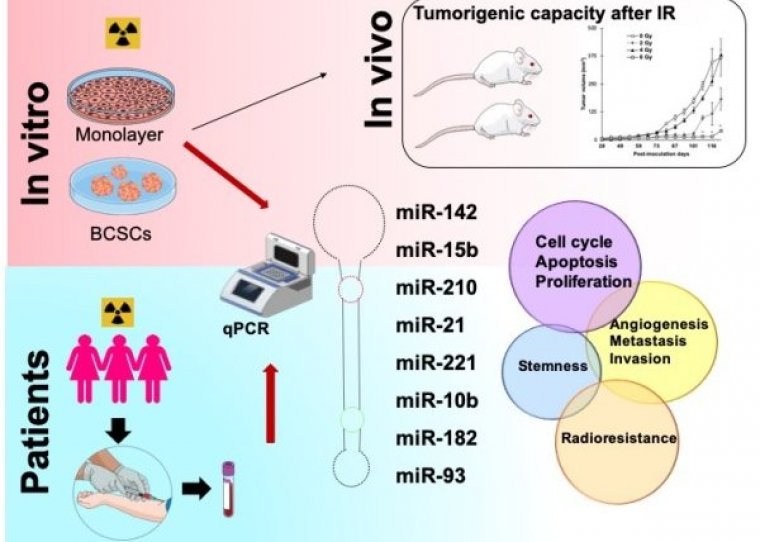| Health / Health News |
Scientists identify new cancer stem cell biomarkers that may help predict response to radiation therapy in breast cancer patients
Breast cancer is the most common cancer among women and one of the leading causes of cancer death worldwide. The presence of cancer stem cells (CSCs) in tumours is associated with a higher rate of relapse, metastasis, and resistance to treatment with chemotherapy and radiotherapy.

Graphic representation of the research conducted on the effect of RT on breast cancer. Photo: University of Granada
Therefore, the radiotherapy (RT) that is so extensively used for the treatment of breast cancer is not always effective, as it is the heterogeneity and biological complexity of the tumour (and, mainly, the CSCs that are part of it) that are responsible for the recurrence of cancer and metastasis following RT.
The microenvironment or niche that surrounds the tumour is another important factor to consider when determining the efficacy of RT among women with different molecular types of breast cancer.
Matrix metalloproteinases (MMPs) are enzymes involved mainly in the remodelling of the extracellular matrix that forms the tumour niche, and they are also involved in carcinogenic processes such as inflammation, the formation of new vessels (angiogenesis), invasion, and metastasis.
It was for this reason that this team of scientists conducted two separate studies to demonstrate that small gene-regulatory molecules (microRNAs) specific to CSCs and MMPs related to the CSC microenvironment are key to predicting the breast cancer patients’ response to RT treatment, depending on the molecular type and the radiation dose used.
In these studies, it was demonstrated that exposure to radiation doses of 2, 4, or 6 Gy affects the phenotype and functional characteristics of CSCs. It was also shown that the microenvironment plays a crucial role in terms of cellular interactions and CSC plasticity in tumour growth following RT.
The tumorigenic capacity of human triple-negative breast cancer CSCs previously treated with the different doses of radiation—following their orthotopic transplantation (implantation) into the mammary tissue of female mice—was evaluated.
The results showed an increase in the tumour volume of the cells exposed to low radiation doses (2 and 4 Gy) compared to both those treated with high doses (6 Gy) and the controls not treated with radiation.
This would support the hypothesis that low doses of radiation in triple-negative breast cancer are insufficient to eradicate CSCs, due to the radioresistance they present; furthermore, these doses might even contribute to tumour growth.
Indeed, conventional RT has been extensively used in the treatment of breast cancer (2 Gy/fraction daily; total 45–50 Gy), but hypofractionated RT is increasingly used, which involves delivering higher doses of radiation combined with shorter treatment times.
The results of this experimental study suggest, therefore, that in these cases the hypofractionated RT would be the most appropriate to avoid the selection of more resistant and aggressive CSCs.
In recent years, it has been shown that variations in the expression of miRNAs and MMPs can contribute to the development of breast cancer in different molecular subtypes following different radiation doses.
Therefore, these researchers studied the expression of eight micro RNAs, also known as miRNAs (miR-210, miR-10b, miR-182, miR-142, miR-221, miR-21, miR-93, and miR-15b).
These play an important role both in carcinogenesis and in maintaining the characteristics of the CSCs and radioresistance. These miRNAs presented variability of expression according to the molecular type of the breast cancer under study and the different subpopulations of tumour cells post-irradiation.
For example, it was shown that miR-21 and miR-182, which are associated with the response to radio-induced DNA damage, increased their expression levels after CSC irradiation for both triple-negative and hormone-dependent breast cancer, which is linked to their increased radioresistance.
In contrast, the expression of mi-142 and miR-15b (associated with increased sensitivity to radiation) increased after treatment with high doses of radiation in hormone-dependent breast cancer CSCs.
Therefore, these miRNAs linked to radioresistance, tumour growth, and radiosensitivity could be used as radio-response biomarkers in breast cancer.
Similarly, the study also focused on MMPs, which are enzymes regulated by their endogenous inhibitors (tissue inhibitors of metalloproteinases, or TIMPs) and by epigenetic mechanisms by histone deacetylases (HDACs).
The results showed that, with radiation, the expression levels of MMP-1 and MMP-3 increased in triple-negative breast cancer CSCs, which points to their importance in the process of invasion and metastasis post-treatment.
Finally, those same miRNAs and MMPs were analysed in breast cancer patients before, during, and after RT.
Variation in the expression levels of these molecules was observed throughout the RT, as was a statistically-significant relationship between these levels and certain variables linked to the particular characteristics of the patient and the tumour biology (such as the histological grade of tumour, age, condition, menopausal state, treatment with chemotherapy or toxicity).
Furthermore, among patients with tumour recurrence, an increase in the blood levels of all the MMPs analysed and a decrease in TIMP-1 levels were found. Likewise, statistically-significant relationships were found for MPMP-3, MMP-9, TIMP-3 and TIMP-4, as well as in miR-182, miR-21, miR-142, miR-210, and miR-10b, with some variables analysed.
This study points to the use of these molecules as possible prognostic and predictive biomarkers of RT-response and radiotoxicity in patients with breast cancer.
In light of these studies, the researchers conclude that the clinical implementation by liquid biopsy of certain miRNA and MMP signatures could be very useful in determining the efficacy of RT and in achieving personalized, precision RT dosage regimens.
This would improve the prognosis, treatment, and survival of patients with breast cancer. (University of Granada)
YOU MAY ALSO LIKE





